Easy Slow Cooker Soup Recipes
Try easy slow cooker soup recipes for effortless meal prep, comforting flavors, and quick, no-fuss dinners.
Last updated: November 17, 2025
When the leaves start to change and the air becomes crisp, it’s the perfect time to warm up with easy slow cooker soups that nearly make themselves. These hearty, satisfying meals save you time and effort, especially when you use Reynolds Kitchens® Slow Cooker Liners for easy cleanup. With some creativity, you can turn leftovers, pantry staples, or seasonal produce into cozy, comforting meals ideal for soup meal prep. Get ready for deliciously simple, quick slow cooker meals that bring warmth to every bowl.
Our Favorite Slow Cooker Soup Recipes

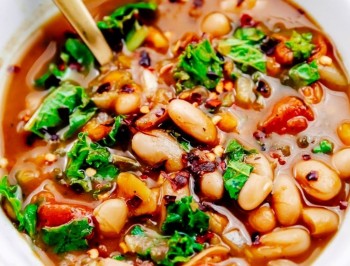
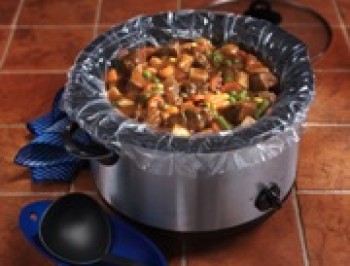


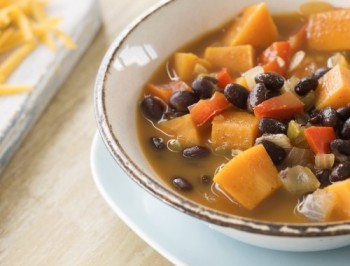
YOU'LL NEED...
Slow Cooker Liners
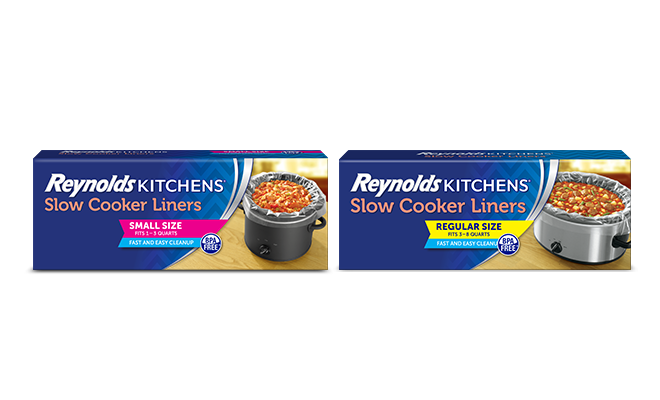
How to Add Your Own Spin to Slow Cooker Soup Recipes
Follow these easy steps to become a pro at making delicious soup in your slow cooker, no matter which ingredients you have on hand. And don’t forget to use a Reynolds Kitchens® Slow Cooker Liner to keep cleanup quick and simple!
Step 1: Gather and prepare your soup ingredients
Want to make cheap slow cooker meals? You can use ingredients you may already have in your pantry, fridge, or garden to create a budget-friendly meal. A hearty soup recipe generally includes:
- Vegetables: carrots, onions, celery, garlic, squash, mushrooms, corn, spinach, kale, cabbage, tomatoes, green beans, zucchini, peppers, or jalapenos
- Liquid: Chicken, beef, or bone broths, vegetable stock or water
- Starchy fillers: potatoes, noodles, pasta, beans, rice, or lentils
- Protein: chicken, beef, turkey, fish, or tofu
- Spices and herbs: bouillon, garlic powder, onion powder, parsley, marjoram, bay leaves, sage, oregano, thyme, turmeric, paprika, lemongrass, ginger, lemon, pepper, or salt
Tip: Dice vegetables like carrots, onions, celery, and peppers uniformly for even cooking. Cut potatoes into similar-sized cubes, but not too small so they don’t fall apart in your soup.
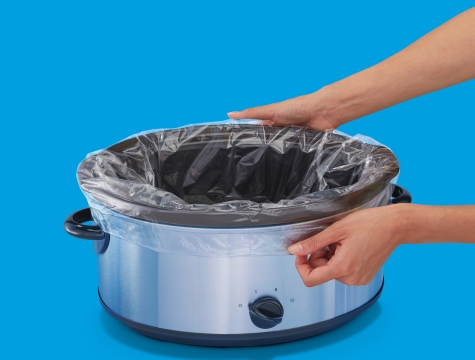
Step 2: Prepare your slow cooker
- Line it right: Fit the liner snugly against the bottom and sides of your slow cooker bowl, then pull the top edge over the rim , leaving at least 2 inches of overhang. This keeps cleanup quick and simple after your dinner. (See full Slow Cooker Liner Directions, Cooking Tips & Recipes for more guidance.) Do not turn on the slow cooker until all ingredients are added and lid is in place
- Layer with care: Start by placing proteins and starchy root vegetables—like potatoes or turnips—on the bottom. Add heartier vegetables next (onions, carrots, celery, peppers, green beans, corn, cabbage, tomatoes, or jalapeños). Sprinkle in hearty grains such as brown rice, quinoa, or wheat berries, then pour in your broth or liquids (a little less than you’d use for stovetop soup). You want the broth or liquid to cover the vegetables by about ½ inch.1 Finish with your favorite seasonings.
- Add delicate ingredients late: For the best texture and flavor, stir in softer ingredients near the end of cooking. Add cooked pasta about 30–40 minutes2 before the soup is done, and 10–15 minutes before the finish, add:
- Leafy greens like kale or spinach
- Tender veggies such as peas, lima beans, or asparagus
- Fresh herbs like basil, dill, oregano, or parsley
- Dairy or plant-based milks, cream, cheese, or yogurt
- Instant or precooked rice3, 4
- Don’t overfill: Keep your slow cooker no more than two-thirds full to ensure even cooking and perfect, hearty results.
- Final step: Once everything’s layered and the lid is in place, then—and only then—turn on your slow cooker. Once the lid is on, sit back, relax, and let your slow cooker do its thing ! Tip: Don’t open the slow cooker lid before the recommended cooking time, unless necessary to add pasta or other delicate ingredients.
Tip: Add cooked pasta in the last 30-40 minutes of cooking to prevent overcooking and excessive liquid absorption.2
Step 3: Flavor your slow cooker soup broth base
Add in your favorite flavors to the base to make a rich, intense broth.
- Make it fresh: Add fresh herbs and spices like lemongrass, ginger, lemon juice, parsley, and leafy vegetables
- Make it hearty: Add chopped potatoes, beans, pasta, rice, lentils, and dense vegetables like carrots, turnips, parsnips, or beets
- Make it spicy: Add spices, sauces, and vegetables with a kick, like cayenne, hot pepper flakes, curry, jalapenos, hot peppers, hot sauce, sriracha, gochujang, or kimchi
Tip: For extra flavor, sear your protein and vegetables separately. They should be lightly browned but not fully cooked. Onions should be translucent. Then, add them to the slow cooker.
Step 4: Cook on low
Low and slow is the secret to soup success. Most soups turn out wonderfully when you let them simmer away on low for 6 to 8 hours—just enough time for all those delicious flavors to come together.
- Brothy soups like chicken noodle or veggie? About 6 hours on low should do the trick
- Hearty soups and stews with beans, grains, or tougher cuts of meat taste best after about 8 hours on low—slow cooking makes everything tender and delicious
- Creamy soups (made with milk, cream, or cheese) work well at 6–7 hours on low; simply stir in the dairy during the last 15–30 minutes to keep it silky smooth
- Quick-cooking soup (like seafood soups or chowders) are best if you slow-cook the base (broth, veggies, seasonings, potatoes, etc.) on low for 4–6 hours or high for 2–3 hours until everything is tender and flavorful. Then, add your seafood near the end, about 20 to 30 minutes before serving. Fish, shrimp, scallops, or crab cook quickly and stay tender this way5
Step 5: Serve with soup garnishes and toppings
Add soup toppings and garnishes immediately before serving such as:
- Fresh herbs, salt, and pepper
- Quality olive oil
- Citrus slices or zest, like lemon or lime
- Toasted nuts or chickpeas
- Crackers, croutons, or tortilla strips
- Sliced of cubed avocado
- Sour cream, yogurt, or crème fraiche
- Shredded cheese, crumbled cheese, or parmesan cheese
- Crusty bread
After enjoying your hearty dinner soup, cleanup becomes quick and hassle-free with a slow cooker liner. Simply transfer the leftover soup to storage containers and toss the liner in the trash—no scrubbing needed!
Frequently asked questions about soup in a slow cooker
How do you thicken soup in a slow cooker?
If your soup turns out a little thinner than you’d like, no worries! Try one (or a few) of these simple tricks to give it that perfect cozy consistency:
- Let it simmer: Simmer on low, uncovered, for about 30 minutes so extra moisture can gently evaporate
- Mix up a quick slurry: In a small bowl, mix 1 tablespoon of flour, cornstarch, chickpea flour or masa harina with 1 tablespoon of water (per 3 cups of soup). Stir until the mixture is completely dissolved, then pour it into the soup and gently stir. Cook on low heat until thickened
- Blend it smooth: Ladle out a cup or so of the soup and blend with a blender or immersion hand blender for a creamy texture
- Stir in something rich and creamy: Add evaporated milk, cream, cheese, coconut milk, yogurt, or even pureed avocado
- Add a hearty thickener: Add rice, beans, or cornmeal, for extra body and flavor6, 7
Each option adds its own bit of comfort—so your slow cooker soup turns out just the way you love it!
Should I use the low or high temperature setting for slow cooker soup?
For the most flavorful results, low and slow is the way to go. Letting your soup simmer on low for 6 to 8 hours allows all those delicious flavors to blend, while keeping the meats tender and the vegetables perfectly cooked. If you want to cook your soup all day, cut your ingredients into larger, chunkier pieces so they take longer to cook.
If you’re short on time, the high setting, about 3 to 4 hours, works just fine—it’ll still taste great, just with a slightly lighter flavor.
When should you add pasta to a slow cooker?
Add your precooked pasta during the last 30–40 minutes of cooking so it has time to soak up all those delicious flavors without turning mushy. This gentle finish keeps your pasta perfectly tender and tasty.
Can you overcook soup in a slow cooker?
Yes, even on the “keep warm” or “low” setting, it’s possible to let your soup go a little too long. When that happens, meats can dry out, and veggies or grains can get overly soft.8 For the best flavor and texture, turn off your slow cooker once your soup is done—your taste buds will thank you! To cook your soup all day, cut your ingredients into larger, chunkier pieces, which will take longer to cook.
How long to reheat soup in a slow cooker?
You should not reheat leftover soup in a slow cooker. The USDA recommends against reheating leftovers in a slow cooker. Instead, reheat the food on the stove, in a microwave, or in a conventional oven until it reaches an internal temperature of 165 °F. Then, you can place the hot food in a preheated slow cooker to keep it warm for serving—at least 140°F, as measured with a food thermometer.9
Can you put raw chicken in soup in a slow cooker without cooking it first?
Yes, you can put raw chicken in a slow cooker soup. For hearty soups, you might want to brown or sear the chicken for extra flavor. Chicken or any meat should always be thoroughly thawed before being placed in a slow cooker.
Related Articles:



Resources
1. Christenson, E. (2011, October 27). Crock-Pot Cooking: 7 Principles for Making Better Soup in the Slow Cooker. The Kitchn.
2. Splawn, M. (2019, May 1). 3 Pro Tips for Cooking Pasta Dishes in the Slow Cooker. The Kitchn.
3. Turner, D. (2023, October 31). 11 Tips for Making Soup in the Slow Cooker. Tasting Table.
4. Alexander, E.M. (2024, October 26). A Crock-Pot Veteran Shows Us 13 Mistakes to Avoid When Making Crock-Pot Soup. Food Republic.
5. Kathryn G. (2024, November 26). Slow-Cooker Fish Chowder. Allrecipes.
6. Gane, T. (2025, January 15). 5 Simple Ways to Make Any Soup Thicker. Southern Living.
7. Splawn, M. (2024, February 28). 5 Tips for Thickening Slow Cooker Soups, Stews, and Sauces. The Kitchn.
8. Ree, C. Slow Cooker Chicken Noodle Soup. Damn Delicious.
9. Slow Cookers and Food Safety. USDA Food Safety and Inspection Service/U.S. Department of Agriculture.
